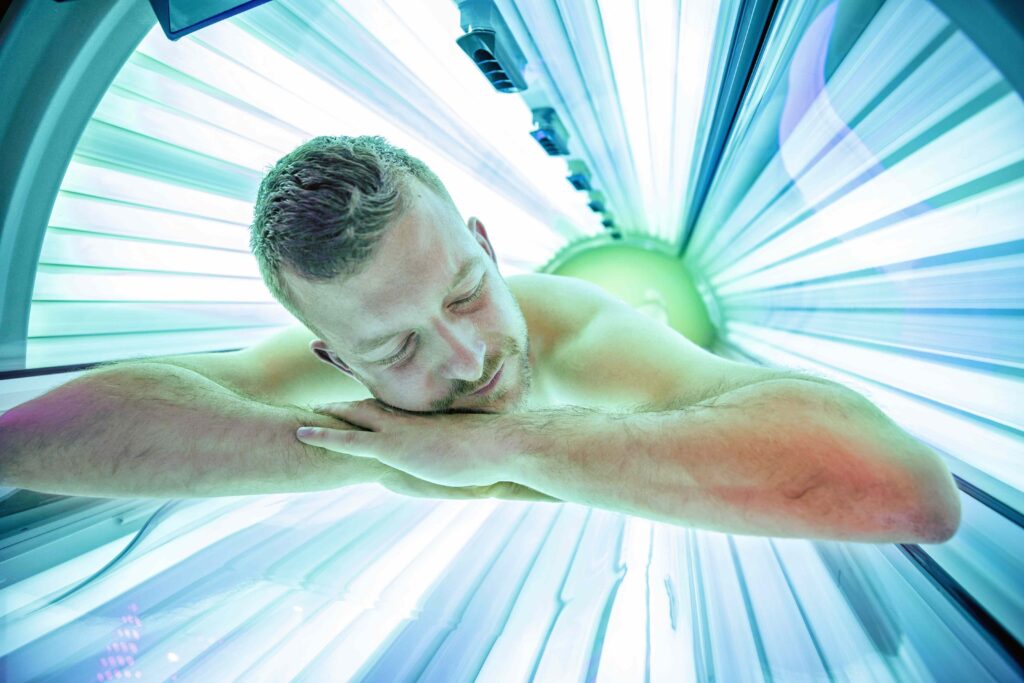A tanning bed rash, known as polymorphic light eruption, can occur a few hours or days after using a tanning bed. The skin reaction appears as an inflamed, itchy, red rash. Healthcare providers believe a tanning bed rash may be a sensitivity reaction to ultraviolet (UV) rays in the tanning bed.
A tanning bed rash is likely related to an immune system reaction to the UV rays that tanning beds expose your skin to. People who are sensitive to UV rays from the sun or tanning beds may experience skin irritation after exposure.
Possible causes of a tanning bed rash or sensitivity include:
- Certain medications that can make you more sensitive to UV, including antibiotics, nonsteroidal anti-inflammatory drugs (NSAIDs), cholesterol medications (statins), and antihistamines
- Dry skin
- Chronic conditions that can cause your skin to become light-sensitive, including eczema, psoriasis, and lupus
- Using skincare products that contain retinol, glycolic acid, or benzoyl peroxide
A tanning bed rash usually appears within hours to days of exposure to a tanning bed. It can occur on any areas of your body exposed to UV rays. A tanning bed rash usually lasts for a few days and then resolves on its own, though it can last for weeks to months if you regularly use tanning beds.
Possible signs of a tanning bed rash include:
- Raised bumps that may blister
- Itching
- Redness
Rarely, additional symptoms may occur, including:
- Fever
- Headaches
- Not feeling well (malaise)
Reproduced with permission from © DermNet dermnetnz.org
Most tanning bed rashes resolve on their own after a few days, but they can be uncomfortable as you wait. To soothe your tanning bed rash, consider applying at-home treatments such as:
If you plan to spend time in the sun while you have the rash, take precautions to protect your skin from further irritation:
- Try to keep any areas of skin affected by the rash covered with clothing.
- Wear sunscreen with a sun protection factor (SPF) of at least 30.
- Take frequent breaks from the sun.
The only way to prevent a tanning bed rash completely is to avoid tanning beds. If you do use a tanning bed, avoid using it while taking medications that make your skin more sensitive to UV rays, such as antibiotics, NSAIDs, and antihistamines.
There are other risks that you can help reduce by avoiding tanning beds, too—most notably, skin cancer. Indoor tanning increases your risk of squamous cell carcinoma by 58% and basal cell carcinoma by 24%. People who begin using tanning beds before age 20 have a 47% increased risk of developing melanoma.
If a tan is important to you, consider using safer options, such as sunless self-tanners. There are sprays, lotions, and gels available to make your skin look tan without UV rays.
In most cases, a tanning bed rash heals on its own within a few days. See your healthcare provider if your rash does get better or if you notice any signs of infection, such as:
- Fever
- Increased redness or swelling
- Pain
- Pus
A tanning bed rash can occur when your immune system has a reaction to the UV rays in a tanning bed. Common signs include an itchy, red, swollen rash. A tanning bed rash usually develops a few hours to days after exposure and typically heals on its own.
Tanning beds raise the risk of skin cancer. To avoid a rash, reduce other risks of tanning, and protect your overall skin health, consider switching to a sunless self-tanner.


